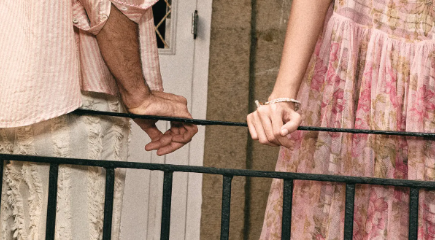
Where have all our friends gone? I’m not talking about the selfie you posted on Instagram last week with your running club buddy (“PBs before 9am!”) or your new yoga friend who just happens to have ten thousand followers. I mean your real friends—the ones you’ve known since school, Brownie camp or university. The “normal” people.

It would be easy to blame the algorithm for making us nervous about our pictures reaching the outermost corners of the internet. Which, though true, feels like an excuse. The real issue, I think, is how social media encourages us to behave: to be the shiniest, most exaggerated versions of ourselves. We’re rewarded for who we know and how well we show them off, which means sharing your normcore friends isn’t seen as cool, or aspirational. Even solo selfies are preferable. “Most of the time I just look like I live alone and sometimes go to the beach,” says Clare, 41.
For so long, social media was the place where our most meaningful friendships lived. We all followed one another—real people we knew in real life. Our Facebook albums were full of group shots, everyone hugging as though we were in the Friends title sequence. It was cool to show off as many of your mates as possible—that performative element has always been there—but at least they were your actual mates, warts and all. Now, they’re disappearing. How many times have you looked at someone’s Instagram and wondered where their real friends are?

Everyone's maxed out their glam this festive season, as we're sure your feed has been proof of. But now that we have a beat of rest, maximalism is giving way to balance. We're seeing controlled bronzing over heavy contour, à la Alia Bhatt, hydrated bases instead of glassy shine and neutral tones instead of blush blindness. The focus is on refining texture rather than adding layers, while hair and brows have been beautifully used to frame and lift the face with minimal interference.
Yami Gautam's skin has a natural, blurred finish that comes from using a fine-milled setting powder. There's minimal contouring, just subtle warmth through the cheeks. Brows are softly defined, lashes separated and eyes lined with brown kohl. The peachy-coral satin lips are a breath of fresh air amongst all the nudes and pinks we've been seeing.
Alia Bhatt's molten makeup emphasises controlled luminosity: a hydrated base layered with light foundation mixed in generously with a liquid bronzer and diffused highlighting on the temples and high points. The eyes followed a warm-toned palette with light brown across the lids and a touch of gold shimmer. The brows stayed full and the lips neutral. The result is a continuation of the glass-skin trend, but executed to look like a gorgeous, bronzed tan.
Throughout their relationship, the couple kept returning to the coast, building memories on the sandy stretches of Santa Cruz and the long curve of California’s shoreline. It felt natural, then, that their wedding destination would reflect their love for the sun, sand and sea. They narrowed it down to three places that brought together the tropics and practical travel routes for their guests: Bali, Thailand and Italy. “I remember the first time I visited Bali; I instantly fell in love. The cliffside views, the food, the resemblance to Indian culture, just the overall vibe,” says Gahoonia. “It was also perfectly located for our relatives who are travelling from all around the world,” adds Bhatia.
AYANA Resort Bali, set against clear waters and rugged cliffs, became home to their four-day celebration with 150 guests. The festivities opened with a tropical green and white welcome dinner at the AYANA Rock Bar. Gahoonia wore a red floral embroidered lehenga by Mahima Mahajan paired with oversized emerald and kundan earrings, while Bhatia chose a black open jacket and kurta set from Varun Chakkilam. “We wanted the welcome dinner to feel relaxed and easy, especially since many of our extended families were meeting for the first time,” says Bhatia.
Day two unfolded with the Haldi and Maiyan ceremony in the morning and the Sangeet in the evening. Dressed in breezy Payal Singhal outfits, the couple leaned into an all-yellow palette for the morning rituals. “We wanted the space to feel like an Indian bazaar, so we added stalls with traditional crafts like bangles, jewellery and candle making,” says Gahoonia. The celebrations shifted into a floral Sangeet and ladies’ Mehendi, filled with music and dancing. Gahoonia twirled through the evening in a multicoloured flower-garden lehenga by Gazal Gupta, while Bhatia wore a red sherwani by Kalki.
Once upon a time, weekends were for life. For discovering a new park to host a make-believe badminton tournament, cinema halls that smelt faintly of caramel and for that one friend who could make you laugh until your stomach ached.
Now, we count down to the duvet cocoon, phone balanced on chest, snacks within reach and the comforting illusion of rest we like to call bed rotting. It's hard to pinpoint the exact time my weekends started looking like a fan whirring above the soft static of Instagram Reels and the faint sound of pressure cooker whistles from someone else’s Sunday lunch. It’s a tableau of modern rest that leaves you more foggy than free. When the week feels like too much, this feels like control. But by Sunday night, I feel oddly hollow instead of refreshed; that’s the catch.
“When stress and anxiety rise, our tolerance for stimulation drops,” says Renuka Gandhi, clinical psychologist and counsellor. “We start choosing isolation, even when what we really need is interaction. It’s a protective reflex that can sneakily make us lonelier.”
The reality is that bed rotting has become synonymous with self-preservation, especially for young Indians constantly toggling between 10-hour workdays and family obligations that don’t recognise weekends. The city doesn’t slow down. You can still hear the honks, the neighbours fighting over parking and the never-ending construction. So we retreat to the one space we can control: our bed.
Loading More post